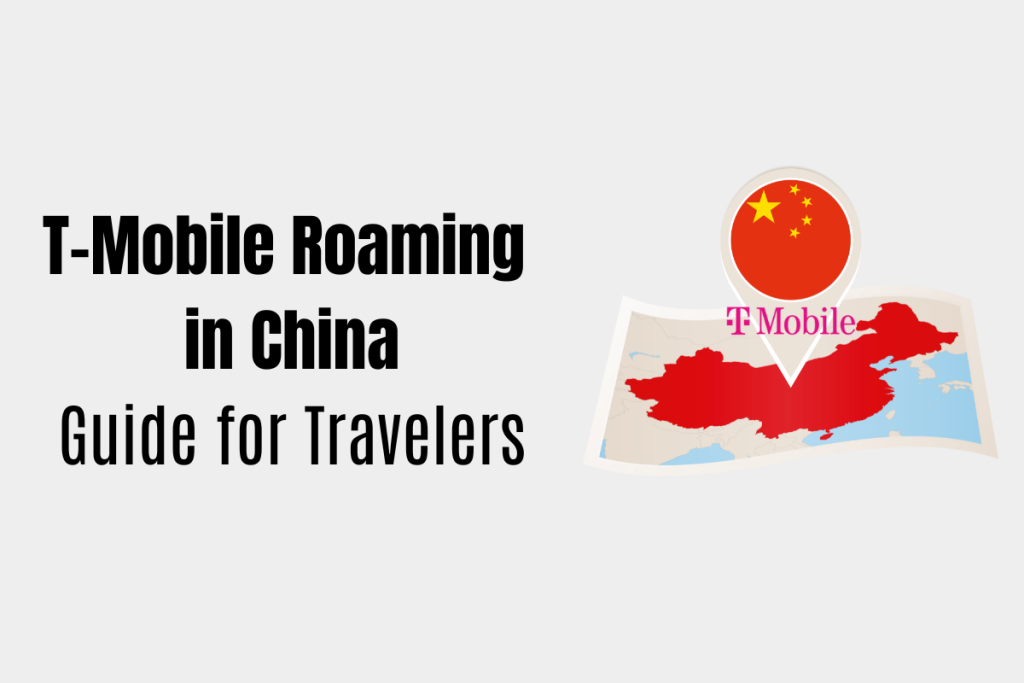Heading to China and wondering how T-Mobile Roaming in China works? This guide breaks down everything you need to know to stay connected, from how T-Mobile Roaming in China functions to its costs, setup steps, and challenges. Plus, we’ll share cheaper alternatives like eSIMs and simple tips to save money, so you can enjoy your trip without worrying about high bills.

I. Does T-Mobile Work in China?
Yes, T-Mobile works in China through partner networks like China Mobile and China Unicom, allowing your phone to connect. This service is available for postpaid customers on plans like Magenta, Magenta MAX, or Business plans. Roaming means your phone uses a Chinese network, but T-Mobile bills you, so no new SIM card is needed. However, there are challenges:
- You’ll likely get slow 2G or 3G speeds, not fast 4G or 5G.
- China’s internet rules block apps like Google, WhatsApp, and Facebook, and T-Mobile roaming doesn’t bypass these blocks. To use roaming, you must enable it before you travel.
II. Preparing Your Phone for China
Before you go, make sure your phone works with China’s networks. China uses GSM and LTE networks, and most phones made after 2016 are compatible. Check if your phone supports LTE bands used in China, like Band 1, 3, or 41. You can confirm compatibility with T-Mobile or your phone’s manufacturer. Also, ensure your phone is unlocked for international use to avoid connection issues.
III. T-Mobile Roaming Options in China
The cost of using T-Mobile in China depends on whether you’re a postpaid or prepaid customer.
- Postpaid customers can use an International Pass for a flat daily fee, which includes calls, texts, and some data.
- Prepaid customers or those without a pass pay high per-action rates and get no data, making it less practical.
Here’s a clear table of costs:
| Service | Postpaid (International Pass) | Prepaid (Pay-As-You-Go) |
| International Pass | $5/day (unlimited talk, text, 512MB data) | Not available |
| Calls | Included in pass | $3.59/minute |
| Sending Texts | Included in pass | $0.50/text |
| Receiving Texts | Free | Free |
| Data | 512MB/day (high-speed) | Not available |
Postpaid customers can add the International Pass via the T-Mobile app (T-Life). It works in over 215 countries, including China, and is more affordable than pay-as-you-go rates. Prepaid roaming is expensive and doesn’t include data, so it’s not recommended.
IV. How to Set Up T-Mobile Roaming
To use your phone in China, enable roaming before you leave:
- Open the T-Mobile app (T-Life) or contact T-Mobile to turn on roaming.
- Add the International Pass if you’re a postpaid customer and want the $5/day plan.
- Set a spending limit on the app to control costs.
- Turn on data roaming in your phone’s settings to connect to Chinese networks.
V. Problems with T-Mobile Roaming in China
T-Mobile roaming is convenient but has challenges. The slow 2G or 3G speeds can make browsing or streaming difficult. China’s Great Firewall blocks apps like Gmail, YouTube, and Instagram, and T-Mobile roaming doesn’t help you access these. For heavy internet users or long trips, the 512MB daily data limit on the International Pass may not be enough, and pay-as-you-go rates are costly.
VI. Alternative Options to T – Mobile Roaming in China
Instead of relying on T-Mobile roaming, try these budget-friendly options:
- Public WiFi: Available in hotels, airports, cafes, and malls. It’s free but not secure, so use a VPN to keep your data safe.
- Local SIM Card: Buy one from China Mobile, China Unicom, or China Telecom at airports or stores. You’ll need your passport, but local data plans are often cheaper.
- eSIM: Get an eSIM from providers like China eSIM for unlimited data at local rates. Set it up with a QR code before you go, and check if your phone supports eSIMs. Visit https://chinaesim.com/esim/china-unlimited-data/ for easy, unlimited plans.
- Portable WiFi Device: Rent or buy a small WiFi hotspot to connect multiple devices, ideal for families or groups.
VII. Tips to Save Money and Stay Online
To keep costs low and stay connected, follow these simple steps:
- Use WiFi whenever possible to save data.
- Turn off auto-updates and background data on your phone.
- Download maps, videos, or translation apps before you travel.
- Use WeChat for messaging and payments, as it’s widely used in China.
- Check your roaming settings to avoid unexpected charges.